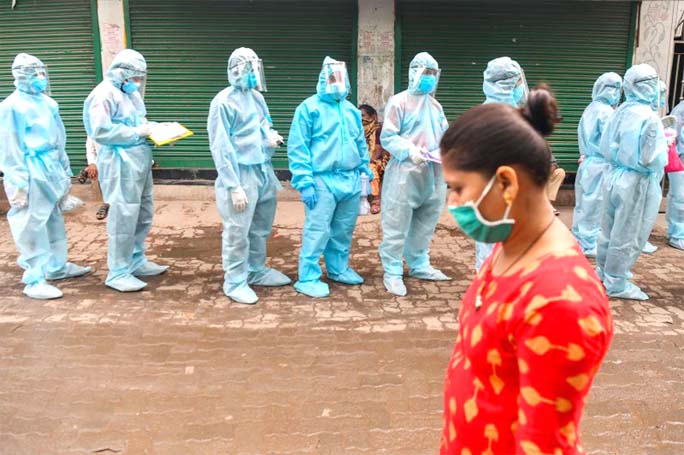
Time :
India reported its highest daily increase in recorded COVID-19 deaths so far on Wednesday, taking the country’s death toll up by more than 2,000 to 11,903.
The majority of the 2,003 new deaths recorded Wednesday were largely down to counting technicalities, with deaths from previous days, mostly in June, being recorded for the first time. The average daily death toll for the seven preceding days was much lower and more constant, at 348 per day. Still, experts fear the country will face larger increases in confirmed cases in the coming weeks, with confirmed cases in India rising at one of the fastest rates in the world. They reached a total of 354,065 on Wednesday, making the country the fourth worst-affected globally after the U.S., Brazil and Russia. Confirmed cases in India are doubling every 18 days, more quickly than each of those countries, even as the Indian government continues to ease tough lockdown measures it imposed in March. On Monday, the chief minister of Tamil Nadu, one of the worst-hit states in the country, said a stringent lockdown would be reimposed in the south Indian city of Chennai and its surrounding districts, beginning on Friday. Confirmed cases in the city have now passed 48,000. And earlier in June, the deputy chief minister of Delhi warned the number of cases in the capital could rise as high as 550,000 by the end of July, requiring 80,000 hospital beds-more than eight times the city’s current capacity. On Sunday, India’s central government announced Delhi would receive 500 more train carriages converted into hospital wards, adding an extra 8,000 beds.
Even so, India’s central government is going ahead with easing lockdown. On June 8, the government allowed temples, mosques and churches across the country to reopen, along with restaurants and hotels. Prime Minister Narendra Modi told state leaders on Wednesday that they should get ready for the next phase of his “unlock” program. “The spread has been kept under control,” he said. “Through timely tracing, treatment and reporting, the number of those recovering is rising.”
While it’s true the number of people recovering is rising, so is the death toll. The majority of Wednesday’s surge came from Mumbai, already India’s worst-affected city by death toll, which recorded 862 new deaths. That brought the city to a total of 3,165, rectifying a counting error from previous days. While a substantial increase, only 55 of those deaths were logged in the last 24 hours, according to city leadership, meaning the increased numbers do not reflect an emergency on the ground. There was also an uptick in the death toll in Delhi, which added 437 deaths on Wednesday, with 93 recorded in the last 24 hours.
India reported its highest daily increase in recorded COVID-19 deaths so far on Wednesday, taking the country’s death toll up by more than 2,000 to 11,903.
The majority of the 2,003 new deaths recorded Wednesday were largely down to counting technicalities, with deaths from previous days, mostly in June, being recorded for the first time. The average daily death toll for the seven preceding days was much lower and more constant, at 348 per day. Still, experts fear the country will face larger increases in confirmed cases in the coming weeks, with confirmed cases in India rising at one of the fastest rates in the world. They reached a total of 354,065 on Wednesday, making the country the fourth worst-affected globally after the U.S., Brazil and Russia. Confirmed cases in India are doubling every 18 days, more quickly than each of those countries, even as the Indian government continues to ease tough lockdown measures it imposed in March. On Monday, the chief minister of Tamil Nadu, one of the worst-hit states in the country, said a stringent lockdown would be reimposed in the south Indian city of Chennai and its surrounding districts, beginning on Friday. Confirmed cases in the city have now passed 48,000. And earlier in June, the deputy chief minister of Delhi warned the number of cases in the capital could rise as high as 550,000 by the end of July, requiring 80,000 hospital beds-more than eight times the city’s current capacity. On Sunday, India’s central government announced Delhi would receive 500 more train carriages converted into hospital wards, adding an extra 8,000 beds.
Even so, India’s central government is going ahead with easing lockdown. On June 8, the government allowed temples, mosques and churches across the country to reopen, along with restaurants and hotels. Prime Minister Narendra Modi told state leaders on Wednesday that they should get ready for the next phase of his “unlock” program. “The spread has been kept under control,” he said. “Through timely tracing, treatment and reporting, the number of those recovering is rising.”
While it’s true the number of people recovering is rising, so is the death toll. The majority of Wednesday’s surge came from Mumbai, already India’s worst-affected city by death toll, which recorded 862 new deaths. That brought the city to a total of 3,165, rectifying a counting error from previous days. While a substantial increase, only 55 of those deaths were logged in the last 24 hours, according to city leadership, meaning the increased numbers do not reflect an emergency on the ground. There was also an uptick in the death toll in Delhi, which added 437 deaths on Wednesday, with 93 recorded in the last 24 hours.

